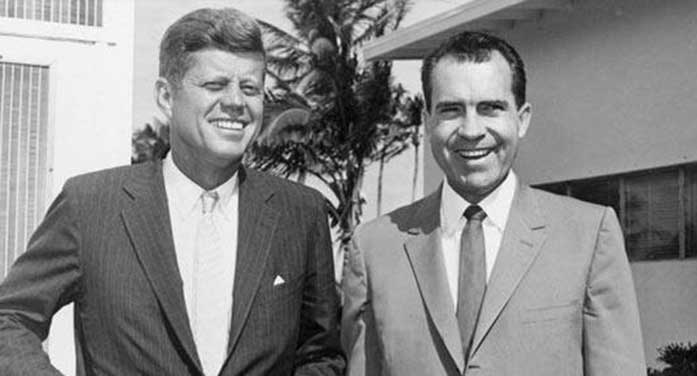 Theodore White’s The Making of the President 1960 set the tone for subsequent conventional wisdom. John F. Kennedy was the handsome, charming, forward-looking hero. And his opponent, Richard Nixon, was the dour, resentful, unscrupulous villain.
Theodore White’s The Making of the President 1960 set the tone for subsequent conventional wisdom. John F. Kennedy was the handsome, charming, forward-looking hero. And his opponent, Richard Nixon, was the dour, resentful, unscrupulous villain.
White’s many readers would’ve been in little doubt. The prince of light had vanquished the prince of darkness. Now, supported by voluminous notes, Irwin Gellman’s Campaign of the Century begs to differ.
Politically, Kennedy’s victory fell far short of a sweep. There was nothing resembling a mandate for major change.
Whereas Nixon ran five to seven per cent ahead of his party’s ticket, Kennedy ran nearly eight per cent behind his. Nixon also took five of the eight geographical regions and 26 states – the latter making it the first time a candidate won the majority of states but lost the election.
The return of the Catholics constituted Kennedy’s single biggest advantage.
Having started to flirt with Republicans in Dwight Eisenhower’s 1952 and 1956 presidential runs, Catholics massively swung back to their traditional Democratic loyalty. This was consistent with the private arguments made by Kennedy’s strategists while he pursued the nomination. Rather than being a liability, the lure of the first Catholic president and the geographical distribution of the Catholic vote would turn his religion into an electoral asset.
There’s also the matter of the razor-thin popular vote margin, approximately 113,000 out of the almost 69 million cast. But that depends on how you count Alabama.
Alabama was a Democratic stronghold back then, part of the Solid South hangover from the Civil War. However, not all of its Democratic voters were enamoured with Kennedy. His support of the civil rights movement – however tepid – didn’t sit well.
And unlike other states, neither Kennedy nor Nixon’s names were directly on the Alabama ballot. Instead, voters got to separately choose 11 individual electors.
So on Election Day, Democrats won all 11 spots, but six of them went to unpledged states-rights electors and just five went to electors pledged to Kennedy. Subsequently, the unpledged six cast their Electoral College votes for segregationist Democratic Sen. Harry Byrd.
There are several ways of apportioning Alabama’s popular vote between Kennedy and Nixon, the most customary of which puts Kennedy comfortably in front. However, if he’s instead allocated just five-11ths of the state’s total Democratic vote – which would match the proportion of Democratic electors he won – then his tally drops sufficiently that Nixon becomes the national popular vote winner.
Of course, the United States doesn’t choose its president in a national plebiscite but rather through separate elections in the various states with the ultimate winner being mediated through the Electoral College. And Kennedy won decisively on that score.
Or did he?
There are genuine, albeit unresolvable, questions about two states – Illinois and Texas. Between them, they had 51 electoral votes in 1960, all of which went to Kennedy. If they were both flipped to Nixon, he’d have won the Electoral College.
Illinois was the closest. With more than 4.7 million votes tabulated, Kennedy’s margin was 8,858. But Richard J. Daley, Chicago’s mid-20th century Democratic mayor, was infamous for strategic vote manipulation.
The Bay of Pigs fiasco upended J.F.K.’s presidential honeymoon by Pat Murphy
In his first serious foreign policy test in 1961, the new American president flunked badly. He was in way over his head
And there was significant anecdotal evidence of fraud. A subsequent study by historian Edmund Kallina calculated that Nixon was shorted by at least 7,968 votes in Chicago. Note the “at least” bit.
As for Texas, in 1960 it was a one-party Democratic state, controlled by Lyndon Johnson and his affiliates. They, too, had a reputation for giving the vote counts a nudge when necessary and anecdotal evidence of such shenanigans abounded. Whether it was enough to account for the 46,233-vote margin is a different question.
Still, writing in 2016 and referring to Illinois and Texas, Ohio State University law professor Edward B. Foley concluded “we will never know for sure whether Kennedy won ‘fair-and-square’ because Nixon lacked a mechanism for challenging the accuracy of the returns that showed Kennedy the winner.”
Although Gellman’s sympathies are clearly with Nixon – who he believes “ran by far the more honourable, and honest, campaign” – his overriding objective is to get rid of the hero/villain frame that’s often used to tell the story: “The time has come to remove partisan blinders and to understand Nixon and Kennedy, two complex, driven, powerfully ambitious men, on the basis of what they actually said and did.”
The case he makes should be carefully assessed rather than cavalierly dismissed. But dislodging a deeply-entrenched narrative is swimming upstream.
Troy Media columnist Pat Murphy casts a history buff’s eye at the goings-on in our world. Never cynical – well, perhaps a little bit. For interview requests, click here.
The opinions expressed by our columnists and contributors are theirs alone and do not inherently or expressly reflect the views of our publication.
© Troy Media
Troy Media is an editorial content provider to media outlets and its own hosted community news outlets across Canada.


